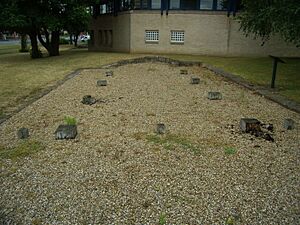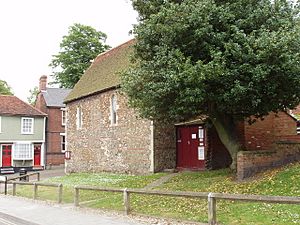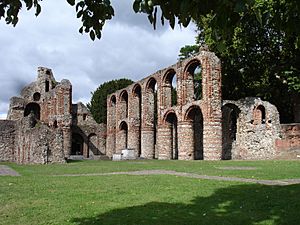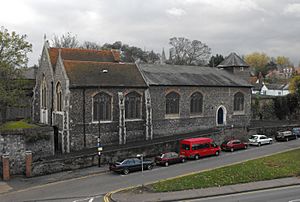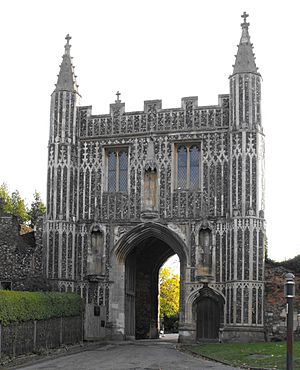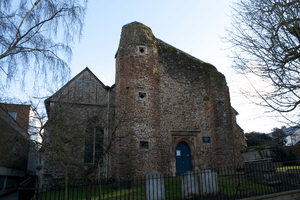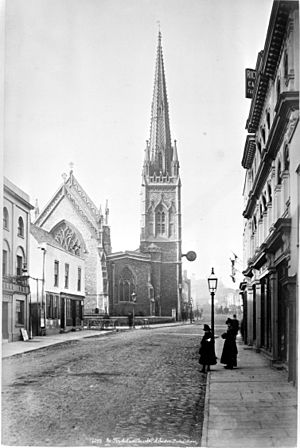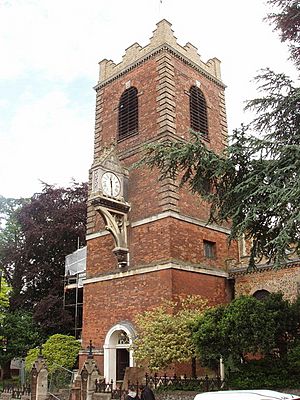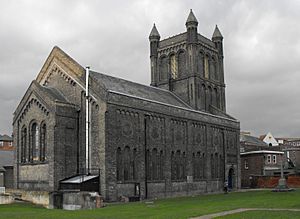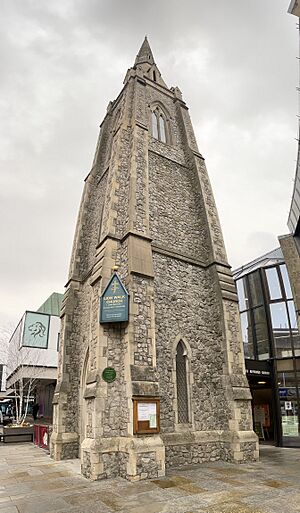Churches in Colchester facts for kids
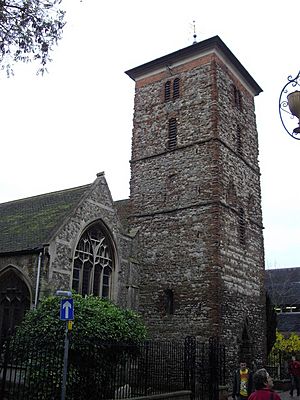
Colchester in Essex, England, has many interesting churches. Some are very old, dating back to Roman times, while others are more modern. They each have unique stories and features.
Contents
Ancient Churches of Colchester
Butt Road Roman Church
In the 1980s, during digging for a new police station, archaeologists found 371 Roman graves. They also found a long, narrow building. This building was constructed between AD 320 and 340. Later, a rounded end, called an apse, was added to its east side.
Experts believe this building was likely an early Christian church. If this is true, it would be the oldest known Christian church in Britain! You can still see the preserved remains of this building from a public path today.
St Helen's Chapel
This chapel is dedicated to Saint Helena. An old book from the 14th century, the Chronicle of Colchester, says that Saint Helena herself founded the chapel. It was rebuilt in 1076. Most of the building you see today is from the 12th and 13th centuries. It even includes old Roman bricks!
Archaeologists found that the Roman stone and brickwork under the chapel's walls were once part of a Roman theatre. Over the centuries, St Helen's Chapel has been many things: a house, a school, a library, a Quaker meeting-house, and a warehouse. Since 2000, it has been used again as a place of worship by the Eastern Orthodox Church.
Medieval Churches
All Saints Church
All Saints’ Church is a 12th-century church on Colchester High Street. In 1953, it was no longer used as a church. Now, it is home to the Natural History Museum, Colchester. It has a beautiful tower made of flint from the 15th century.
St Botolph's Priory
The Augustinian priory of St Botolph was built in the 11th century. Around 1200, it became the main church for the Augustinian order in Britain.
During the time when monasteries were closed down in England, St Botolph's Priory church became a local parish church. It was used for town events until the English Civil War. In 1650, after the Siege of Colchester, the church was described as burned and ruined. It has remained in ruins ever since.
St Giles, St John's Green
This church was first built around AD 1150 on part of St John's Abbey cemetery. It has parts from every century since then. In 1956, it stopped being used as a church. It was then used by St. John Ambulance until 1975. After that, it was changed into a masonic centre.
Holy Trinity Church
Holy Trinity is the oldest church building still standing in Colchester. It is on Trinity Street in the town centre. Parts of its tower are Anglo-Saxon, thought to be from about 1020. The Saxon doorway on the west side of the tower has a unique triangular top.
The churchyard is the resting place of famous people. These include William Gilberd, who discovered electromagnetism and was a doctor to Queen Elizabeth I. The composer John Wilbye is also buried there.
St James the Great
St James the Great is a Church of England church on East Hill. The oldest part of the church is Norman, from the 12th century. The main part of the church, its tower, and two side sections were built between the 13th and 15th centuries.
The radical priest John Ball, a leader of the Peasants' Revolt in 1381, preached at this church.
St John's Abbey
The Benedictine abbey of St John the Baptist, known as "St John's Abbey," was founded in 1096. It had a church from the late 11th century. However, during the Dissolution of the Monasteries, the abbey was closed, and its abbot was executed in 1539.
Today, all that remains is the gatehouse on St John's Green. This gatehouse dates from the 15th century.
St Martin's Church
St Martin's is a 12th-century church that still looks much like its original Norman design. It is on West Stockwell Street in the old Dutch Quarter. Its tower was damaged during the English Civil War and was never fixed.
Today, the church building is looked after by The Churches Conservation Trust. It is used as a place for community events.
St Mary-at-the-Walls
St Mary-at-the-Walls is on Church Street, built against the old Roman walls. It was first mentioned in 1206. This church has a very important history. It is the place where 23 Protestant martyrs were burned during the reign of Queen Mary I.
During the English Civil War, a Royalist army used the church tower to place their guns. This led to its destruction by the New Model Army. The lower part of the tower is Norman. The church building was rebuilt in 1872.
In 1980, the old church building was reopened as the Colchester Arts Centre.
St Nicholas Church
Saint Nicholas' church used to stand on the High Street. The original church was from the 12th century. It was rebuilt in the 14th century and again in the late 19th century. This church had the tallest spire in Colchester.
The Church of England had the church taken down in 1955. The land was then sold for shops and homes.
St Peter's Church
St Peter's is a medieval church on North Hill. It was largely changed in 1758, giving it a more Georgian look, but it still has medieval parts. The churchyard once had a large stone cross where gospels were read during the Palm Sunday procession.
St Leonard's-at-the-Hythe
St Leonard's-at-the-Hythe is a large medieval church located at Colchester's Hythe river port. It was one of only two church buildings in Colchester that had clocks in medieval times.
The church was the site of a battle during the 1648 Siege of Colchester. Its south door still has firing loops for muskets, which were used to shoot from during the battle. The church is now no longer used for regular services and is cared for by the Churches Conservation Trust.
Georgian Churches
Baptist Church
This church in Eld Lane was built in 1834. It stands on the site of Colchester's very first purpose-built Baptist chapel, which was from 1711.
Congregational Chapel
This red-brick chapel in East Stockwell Street was built in 1816–17. It was built for a Congregational minister named Rev. Joseph Herrick. The front of the chapel was updated in 1834 with a pediment and Tuscan columns.
Quaker Meeting House
This building in Church Street is from 1803. It is a Grade II listed building, meaning it is considered historically important.
Victorian Churches
St Botolph's Church
The current St Botolph's church building was opened in 1837. It was designed to look like the old Norman buildings, with rounded arches. The church was almost destroyed by fire during the 1943 air raids in World War II. It had its own team of fire watchers who put out several incendiary bombs.
Garrison Church
Built in Military Road in 1855, this church was made for soldiers going to the Crimean War. It is a large timber church that can hold 500 people. Today, it is the Romanian Orthodox Church of St. John the Wonderworker.
St James the Less
This Roman Catholic Church of St James the Less and St Helen in Priory Street was built in 1837. It was made larger in 1909–10. It is a Norman revival building with a rounded chancel.
United Reformed Church
This Gothic Revival church in Lion Walk was built in 1863. The 1884 Colchester earthquake damaged its tall steeple. In 1972, the church became part of the new United Reformed Church.
Modern Churches
Castle Methodist Church
This 20th-century building in Maidenburgh Street, next to Colchester Castle, opened in 1970. It is on the site of an older "great round meeting house" where John Wesley preached in the 18th century. A wooden pulpit he used is kept in the new church.
Colchester New Church
Colchester New Church at 175 Maldon Road was built in 1924. In 1967, the church building was expanded. The main worship area was made longer, and a new school room and entrance porch were added.
Elim Pentecostal Church
Colchester's Elim Pentecostal group started in 1930. They moved to a new church in Walsingham Road in 1971. The group now meets in an even newer building on Clematis Way.
Greenstead Evangelical Free Church
Greenstead Evangelical Free Church is on Magnolia Drive on the Greenstead estate. It was built in 1963, making it almost as old as the housing estate itself.


